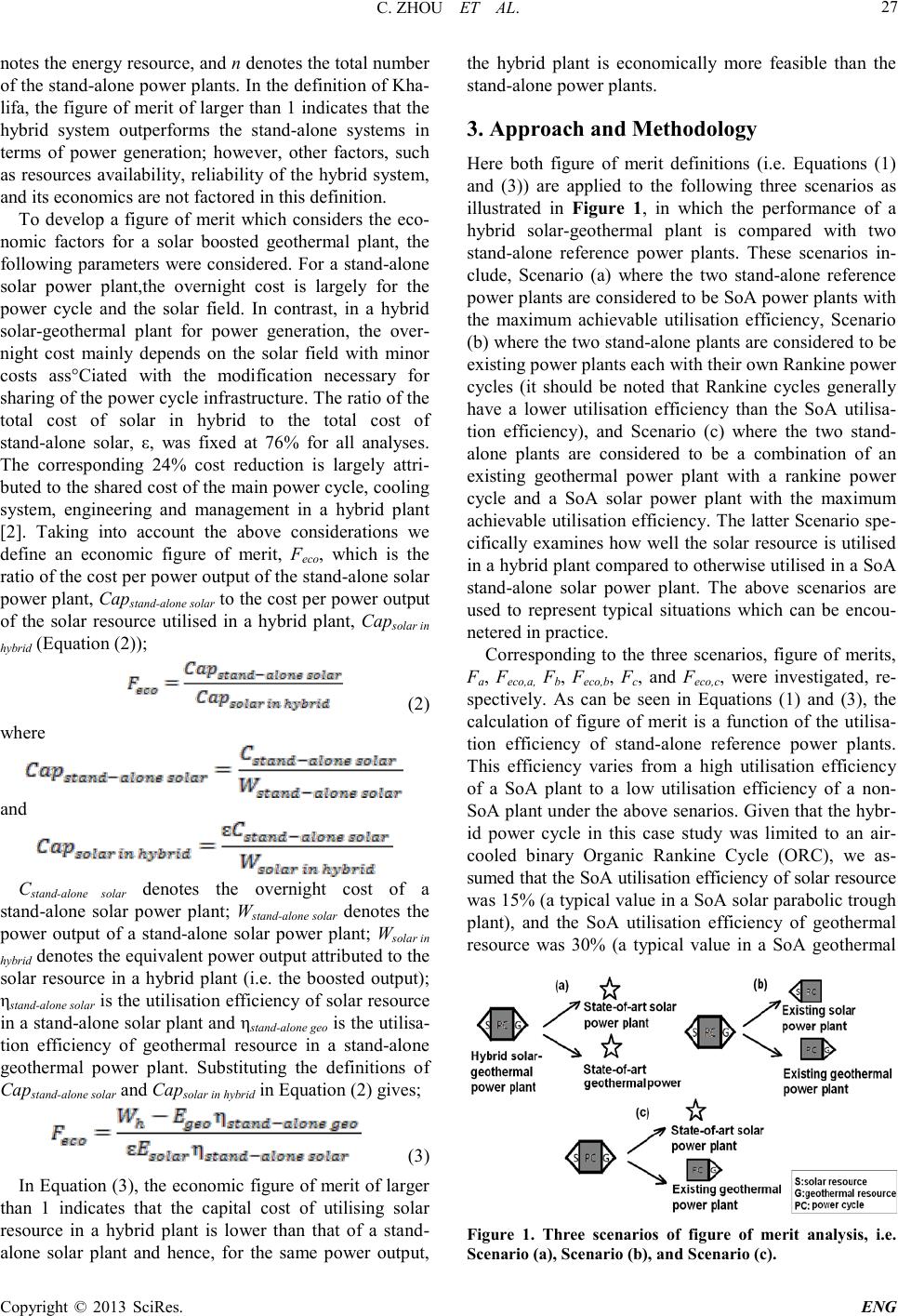
C. ZHOU ET AL.
Copyright © 2013 SciRes. ENG
27
notes the energy resource, and n denotes the total nu mber
of t he sta nd -alone po wer plants. I n the de finition of Kha-
lifa, the figure o f merit o f lar ger than 1 indicate s that the
hybrid system outperforms the stand-alone systems in
terms of power generation; however, other factors, such
as resources availability, reliability of the hybrid system,
and its economics are not factor ed in this defi nition.
To develop a figure of merit which considers the eco-
nomic factors for a solar boosted geothermal plant, the
following parameters were considered. For a stand-alone
solar power plant,the overnight cost is largely for the
power cycle and the solar field. In contrast, in a hybrid
solar-geothermal plant for power generation, the over-
night cost mainly depends on the solar field with minor
costs ass°Ciated with the modification necessary for
sharing of the power cycle infrastructure. The ratio of the
total cost of solar in hybrid to the total cost of
stand-alone solar, ε, was fixed at 76% for all analyses.
The corresponding 24% cost reduction is largely attri-
buted to the shared cost of the main power cycle, cooling
system, engineering and management in a hybrid plant
[2]. Taking into account the above considerations we
define an economic figure of merit, Feco, which is the
ratio of the cost per power output of the stand-alone solar
po wer plant, Cap stand-alone solar t o the cost per power output
of the solar resource utilised in a hybrid plant, Capsolar in
hybrid (Equation (2));
(2)
where
and
Cstand-alone solar denotes the overnight cost of a
stand-alone solar power plant; Wstand-alone solar denotes the
power output of a stand-alone solar power plant; Wsolar in
hybrid denotes the equivalent power output attributed to the
solar resource in a hybrid plant (i.e. the boosted output);
ηstand-alone solar is the utilisation efficie ncy of solar re source
in a sta nd-alone solar plant and ηstand-alone geo is the utilisa-
tion efficiency of geothermal resource in a stand-alone
geothermal power plant. Substituting the definitions of
Capstand-alone solar and Cap solar in hybrid in Equation (2) gives;
(3)
In Equation (3) , the economic figure of merit of larger
than 1 indicates that the capital cost of utilising solar
resource in a hybrid plant is lower than that of a stand-
alone solar plant and hence, for the same power output,
the hybrid plant is economically more feasible than the
stand-alone power plants.
3. Approach and Methodology
Here both figure of merit definitions (i.e. Equations (1)
and (3)) are applied to the following three scenarios as
illustrated in Figure 1, in which the performance of a
hybrid solar-geothermal plant is compared with two
stand-alone reference power plants. These scenarios in-
clude, Scenario (a) where the two stand-alone reference
power plants are considered to be SoA power plants with
the maximum achievable utilisation efficiency, Scenario
(b) where the t wo st and -alone plants are considered to be
existing power plants ea ch with their own R ankine power
cycles (it should be noted that Rankine cycles generally
have a lower utilisation efficiency than the SoA utilisa-
tion efficiency), and Scenario (c) where the two stand-
alone plants are considered to be a combination of an
existing geothermal power plant with a rankine power
cycle and a SoA solar power plant with the maximum
achievable utilisation efficienc y. The latter Scenario spe-
cifically examines how well the solar resource is utilised
in a hybrid plant compared to otherwise utilised in a So A
stand-alone solar power plant. The above scenarios are
used to represent typical situations which can be encou-
netered in practice.
Corresponding to the three scenarios, figure of merits,
Fa, Feco,a, Fb, Feco,b, Fc, and Feco, c, were investigated, re-
spectively. As can be seen in Equations (1) and (3), the
calculation of figure of merit is a function of the utilisa-
tion efficiency of stand-alone reference power plants.
This efficiency varies from a high utilisation efficiency
of a SoA plant to a low utilisation efficiency of a non-
SoA pl ant u nder the above senar ios. G iven t hat the hybr-
id power cycle in this case study was limited to an air-
cooled binary Organic Rankine Cycle (ORC), we as-
sumed t hat the So A utilisa tion e fficienc y of solar r esourc e
was 15% (a typical value in a SoA solar parabolic trough
plant), and the SoA utilisation efficiency of geothermal
resource was 30% (a typical value in a SoA geothermal
Figure 1. Three scenarios of figure of merit analysis, i.e.
Scenario (a), Scenario (b), and Scenario (c).